Abstract
Due to urban population growth, dense communities have emerged as a common approach to improve land utilization and minimize resource consumption to foster sustainable development in cities. In densely populated neighborhoods, the accessibility, availability, and appropriateness of amenities play a crucial role in the sustainable development of cities and residents’ quality of life. This study integrates the distribution of amenities within densely populated cities and utilizes residential assessments to analyze the effectiveness of these amenities in meeting the daily needs of residents. This analysis is based on a survey conducted in the three most populated cities in China. The study utilizes two sets of data: amenity distribution information and a questionnaire regarding the state of amenities and residents’ daily needs. The survey began in 2019 and was completed in 2021. A total of 1060 valid questionnaires were collected, with Shanghai accounting for 42%, and Beijing and Chongqing accounting for 30% and 28%, respectively. The findings demonstrate a higher density of amenities in populous areas, indicating a response to the overall requirements of residents. In these areas, the transportation network is extended more widely. Moreover, neighborhoods equipped with outdoor green spaces, ample parking, security services, and accessible public institutions received positive evaluations from residents, as they actively fulfilled their living needs. In neighborhood planning, prioritizing the coverage and quantity of these amenities can enhance the functionality and effectiveness of dense residential areas. This approach promotes sustainable development goals by improving the efficiency of urban resource allocation and establishing a convenient neighborhood environment.
1. Introduction
In China, the surge in urban populations has propelled the advancement of the urbanization process. As the seventh census report indicates, urban residents constitute 63.89% of the total population, with a noteworthy overall population growth of 14.21%. By the end of 2011, China was home to 17 cities harboring populations exceeding 10 million residents [1]. Rapid economic growth has driven population inflows to these cities, with people in search of more job opportunities [2]. This situation has led to a growing significance of urban quality of life for a larger number of people [3,4]. Moreover, uncontrolled urban sprawl leads to a transformation in agricultural land [5] and an increase in energy consumption [6,7]. To effectively address urban development challenges, the 14th Five-Year Plan of China (2020–2025) has established urban planning targets that prioritize sustainable and high-quality urbanization [8]. The central government is dedicated to utilizing resources efficiently to create livable environments. Hence, densely populated cities must develop more efficient neighborhoods capable of accommodating numerous residents and meeting their diverse needs and demands [9].
Neighborhoods not only fulfill the social service function of the city but also serve as spaces for citizens to interact, ultimately contributing to residents’ well-being and quality of life in the context of sustainable urban development [10,11]. Generally, neighborhoods comprise two key components: physical and socio-environmental factors, which can significantly impact residents’ satisfaction [12,13,14,15]. Physical factors include the accessibility of amenities, services, and other public facilities, while socio-environmental factors comprise daily activities, crime rates, and social interactions [16,17]. The provision of amenities within the living environment holds crucial importance in residents’ daily lives [16], playing an essential role in determining the habitability and functionality of residential areas [18,19]. Consequently, a suitable residential community should meet the demands of its residents by providing both appropriate physical elements and a positive social atmosphere [20,21].
Apart from fulfilling basic material needs, amenities in neighborhoods serve another crucial function by addressing fundamental life demands [10,22,23]. People generally invest a lot of time participating in physical activities and social interactions within their neighborhoods [16]. Accordingly, amenities hold substantial importance in shaping social conditions, providing convenience, and elevating the overall comfort of daily life [18,24]. To ensure the stable development of the urban living environment, it becomes imperative to conduct further evaluations of existing neighborhoods and amenities from the perspective of residents’ lived experiences.
Given the current state of densely populated communities, neighborhoods that provide accessible and functional amenities play a crucial role in fulfilling the basic material needs of their residents [6,25]. These amenities should enhance the overall quality of the living environment by offering convenience and practicality [26].
By addressing these questions, this study aims to shed light on the state of amenities and social services in densely populated residential areas and their effects on residents’ daily lives. Specifically, it aims to address the following questions:
- Are the coverage and distribution of amenities or social services appropriate in populous residential areas?
- Are the public institutions or amenities surrounding residential areas consistent with the living needs of the residents?
- Which amenities and residents’ lifestyles could significantly affect residential evaluation?
It is argued that high-density residential areas benefit from increased density, which can reduce land use and travel distances [27,28]. Walking-scale neighborhoods of this kind can provide residents with ample transportation choices and plenty of areas allocated for retail purposes [29]. Furthermore, this type of plan positively enhances the convenience of daily life and contributes to the social economy [30]. A sound design encompasses meeting user needs, comprehending and adapting to the context, and enhancing the neighborhood [31]. This study aims to assess the effectiveness of amenities in dense communities and identify the factors that contribute to enhancing residential comfort in compact residential areas.
The current research on neighborhood amenities is varied and frequently conducted through interdisciplinary approaches. For example, previous studies have concentrated on investigating the impact of specific amenities on different facets, including the housing market [32], social services [33], urban development [34], residential preferences [35], and residential satisfaction [22]. These factors encompass amenity elements such as landscaping [36], transportation [37], educational resources [38], and commercial areas [39], among others.
Kostas and Bengt emphasize that neighborhood planning should address residents’ daily needs and promote local social cohesion [13]. Furthermore, studies are dedicated to exploring the impact of urban amenities on quality of life and enterprise perspectives, providing a deeper understanding of the functions and roles of cities [40]. By examining residents’ actual experiences in utilizing neighborhood amenities within a gated urban framework, Wang et al. (2018) shed light on the current strengths and weaknesses of the Chinese urban planning system [41]. Yu et al. (2019) delve into the role of amenities and economic opportunities in influencing migration patterns in China [42].
Farrukh et al. demonstrated the practical significance of neighborhood facilities in regards to community well-being, which can enhance residential satisfaction and improve the quality of life [11]. Wang et al. examined the contribution of housing usage, neighborhoods, and the affective residential experience to residential satisfaction [28]. Some scholars found that the neighborhood environment [43], public facilities, and housing characteristics are the primary factors influencing residential satisfaction [44,45].
Furthermore, some scholars conduct their research using ordered logistic models to investigate the impact of neighborhood, housing, and demographic factors on residents’ evaluations based on the building environment [46,47,48].
These examples illustrate the intrinsic connection between amenities and the multifaceted development of cities. Multiple types of amenities can influence residents’ living quality. However, these studies did not focus on the environmental characteristics of compact communities to explore how amenities can meet the diverse daily needs of residents. Additionally, few pieces of literature explain which amenities can effectively cater to specific living needs, and which facilities and daily requirements are vital to residents’ living experience and habitability.
Although some scholars have established a relationship between the plan of compact residential areas and urban sustainable development, few have combined residents’ post-use evaluation and the coverage of amenities to elucidate the impact of these factors on urban sustainable development. This study examines a model in densely populated residential areas by considering the life demands of citizens. Furthermore, it investigates the overall effectiveness of amenities through residential evaluations. Improved infrastructure construction and efficient urban resource utilization can contribute to the reduction of energy consumption, resource wastage, and carbon emissions. Creating energy-saving, efficient, and livable neighborhoods is the particular objective of urban sustainable development [49]. The findings of this study provide valuable insights into the efficient utilization of urban public resources, the development of dense settlements, and real estate investment. Moreover, the research holds direct reference value for residential area planning and enhancing the quality of life for residents.
The next section covers the survey and research methodology. Section 3 presents the research findings. The discussion and conclusions of this study are provided in the last two sections of the paper.
2. Methodology
2.1. Research Framework
To adequately address the subject of this paper, the research variables should incorporate neighborhood factors, elements of daily life, and residents’ evaluations. The demographics data were used as control variables in this study.
2.1.1. Amenities in Neighborhoods
The characteristics of a neighborhood play a vital role in promoting urban sustainability, supporting basic daily needs, and determining residential satisfaction [13,26,50]. Neighborhoods that act as “enabling places” [51] by providing opportunities for physical activities, recreation, and social interactions also contribute to overall well-being [28,51]. The presence of amenities in neighborhoods can foster favorable living conditions [52]. Residents’ participation in neighborhood activities positively affects their satisfaction with their living situation [53].
Previous studies have investigated the neighborhood features that contribute to well-being, such as the availability of public service institutions [54], transportation systems [28,55], security [56], retail stores [57], parking and garages [58], spaces for social interaction [59], and the accessibility of green areas [60,61]. Typically, the effectiveness of green and ecological spaces is particularly noteworthy in densely populated districts [62].
Furthermore, in the metropolises of China, children can be enrolled in a nearby public school based on their hukou (the hukou is a registration certificate for a residential location. School-aged children are recruited to schools near their residential districts), which is linked to their housing property, to receive nine years of compulsory education (from primary to junior secondary education) [63]. However, the local government can only provide equal financial support to some public schools. Some better-equipped (key and top) schools are supported by a higher rate of government expenditure than ordinary schools [64]. Consequently, “school district housing” and “education real estate” have become popular concepts in the real estate market [38]. A good school district adds value to the neighborhood and supports the daily needs of residents, increasing their satisfaction with their residential area [65].
In compact cities, inadequate infrastructure, such as limited open space, traffic congestion, and a lack of services and amenities, can hinder residents’ abilities to meet their daily needs. Overall, the availability of amenities is a crucial factor to consider. When services such as transportation, education, and public institutions are easily accessible, residents can better evaluate the quality of their community based on these local characteristics [54].
2.1.2. Daily Life in Neighborhoods
The satisfaction of inhabitants’ fundamental daily needs is a vital factor in the sustainability of the urban environment [6,66]. These needs encompass a range of essential behaviors related to residences, such as consumption patterns and leisure activities [67], as well as other individual or collective preferences [68]. Significant elements in neighborhoods that impact residents’ well-being include commercial activities, public affairs, outdoor exercises, and daily travel [69]. As a result, it is imperative to analyze these factors of daily life to comprehend the efficacy of amenities and the overall livability of communities [54].
Mouratidis (2021) believes that environmental factors are linked to residential evaluation in a conceptual model that includes travel, leisure, work, and social relationships [4]. Commute travel time to the central business district (CBD) or workplace is critical in citizens’ daily lives [70]. Short travel times and active modes increase residents’ satisfaction [4,71]. Compact urban configurations have the potential to mitigate travel times and foster the development of walkable neighborhoods, thereby facilitating a convenient way of life [4].
Morrison’s research (2011) indicates a positive correlation between residents’ access to shops, services, amenities, and their subjective evaluation of their living conditions [72]. Therefore, evaluation indicators are closely related to dwellers’ behavior and lifestyles, such as shopping, managing finances, eating, and entertainment [26,65,73]. Additionally, leisure is an independent life domain that significantly contributes to an individual’s well-being [74,75]. Engaging in outdoor activities not only promotes physical health, but also encourages social interaction. Environmental quality, safety [2], and educational land use are crucial elements of citizens’ daily lives [70]. Thus, the safety of the living environment depends on fulfilling residents’ security needs [76]. Furthermore, residents’ attitudes towards education affect their access to educational resources, making it a crucial factor to consider.
2.1.3. Residential Satisfaction
Residential satisfaction is a direct and practical concept for measuring dwellers’ evaluations. It is influenced by both the social and physical aspects of neighborhoods and mirrors a subjective attitude towards an objective residential environment [46,61,77]. Therefore, residential satisfaction is a medium for assessing the residential experience relating to neighborhoods and everyday life. According to Bonaiuto et al. (2004) [78], satisfaction is primarily based on whether an individual’s goals and needs are supported by their residential environment [79]. Residential satisfaction depends on the externalities households receive, such as local amenities, social capital investment, and neighborhood stability [80]. Because neighborhoods and lifestyles directly relate to residential satisfaction, analyzing these factors can help identify the significant elements affecting residents’ living experiences.
In summary, Table 1 presents all the research variables based on the literature review. (The variable options are configured based on the current situation in China.)

Table 1.
Variables and definitions.
2.1.4. Demographics
Numerous research papers have utilized demographic variables as control variables [81,82]. Individual socioeconomic characteristics often influence residential preferences and evaluations as citizens search for suitable residences that align with their living requirements [83]. Such sociodemographic characteristics encompass age, gender, income, marital status, education level, family size, and living with children [84]. These variables exhibit correlations with the amenities presented in Table 1. They can additionally function as control variables to examine the validity and robustness of the research variables (Details in Table S1 of the Supplementary Materials).
2.2. Survey Area
To conduct our research, we carefully selected survey sites in three highly populated cities in China: Beijing, Shanghai, and Chongqing. These cities are categorized as directly controlled municipalities and boast rapidly developing infrastructures. Their respective populations were 21.88 million, 24.87 million, and 32.05 million in 2020 [85].
Beijing, located in the eastern region of China, holds a significant position as the cultural and political epicenter of the nation. It exhibits a typical concentric center urban structure [86]. According to data from the seventh census, Beijing’s population has increased by 2.281 million individuals over the past decade. Additionally, Beijing has been undergoing constant expansion. The government has taken gradual steps to enhance the city’s ecological environment, accompanied by strict limitations on its size since 2016.
Shanghai, characterized by the highest population density, serves as a prominent economic and trade center. The city has witnessed rapid economic growth and urbanization, leading to gradual improvements in its urban planning model, which combines land resource allocation with market-oriented approaches [87]. In comparison, early Shanghai exhibited indications of concentric circle development [88]. The adoption of a new urban morphology has brought about positive impacts on residents’ quality of life and economic development.
Chongqing ranks as the most populous city in China. It also serves as a prominent economic and trade hub for Southwest China. The urban core of Chongqing comprises nine districts. The core area adjoins its surrounding counties and forms a provincial-level city [89]. Consequently, the primary infrastructure and public institutions are concentrated in the core area. At the same time, other regions have also developed public facilities and amenities to cater to the residents’ daily lives and production needs.
In light of the research subject, the investigators strategically selected survey areas with larger populations and essential amenities (Figure 1). In dense areas, most communities have access control systems, limiting entry to non-residents. Gated communities, in particular, are separated from the surrounding streets by fences or walls, while some age-old communities are more accessible and directly connected to the city streets. The residential areas are predominantly comprised of multi-story and high-rise buildings, complemented by service facilities situated in the vicinity (Figure 2, Figure 3, Figure 4, Figure 5, Figure 6, Figure 7, Figure 8, Figure 9 and Figure 10).

Figure 1.
The surveyed sites.
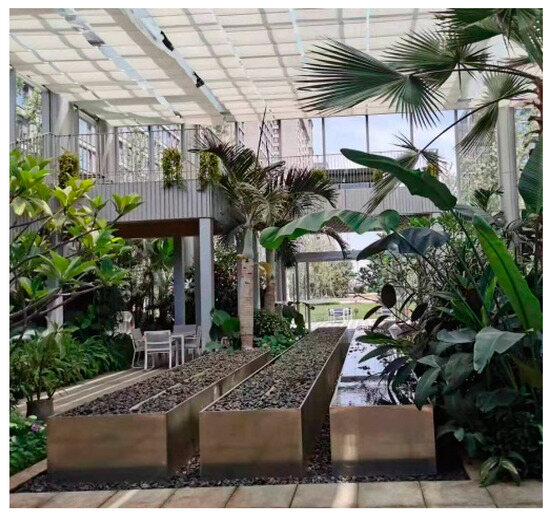
Figure 2.
Entrance to the Xishan Yanlu community in Beijing.
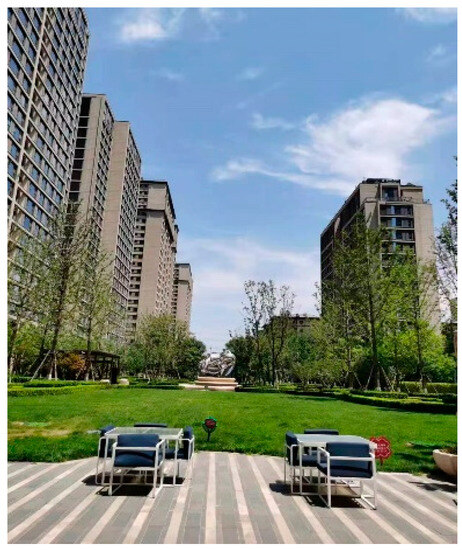
Figure 3.
Internal area of the Xishan Yanlu community in Beijing.
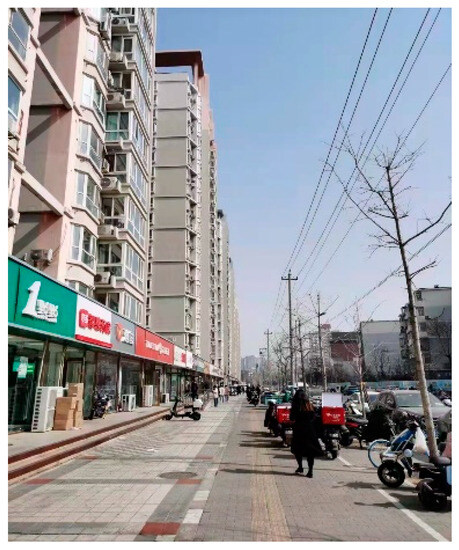
Figure 4.
Apartment buildings along the street in Beijing.
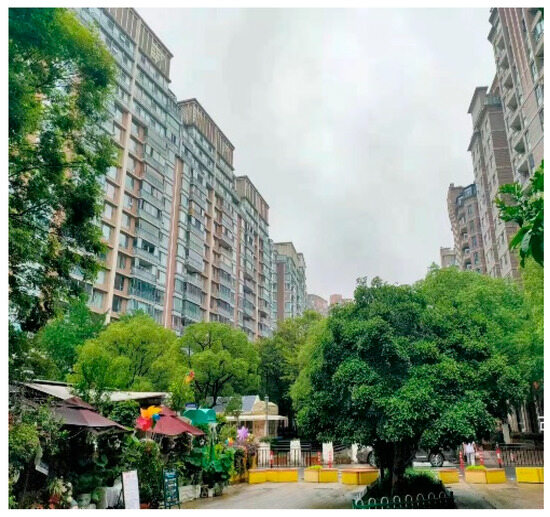
Figure 5.
The Gubei-goji community in Shanghai.
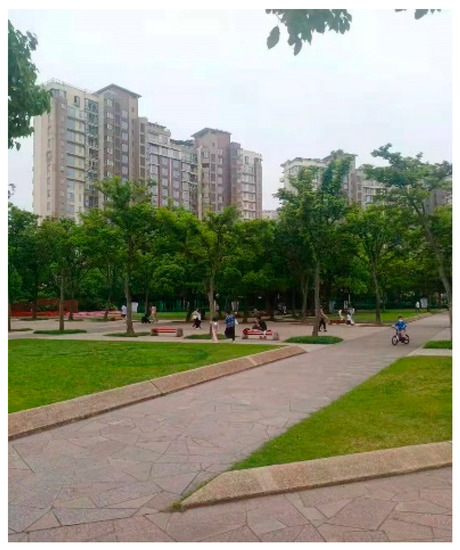
Figure 6.
Park in the Xinwan city community in Shanghai.
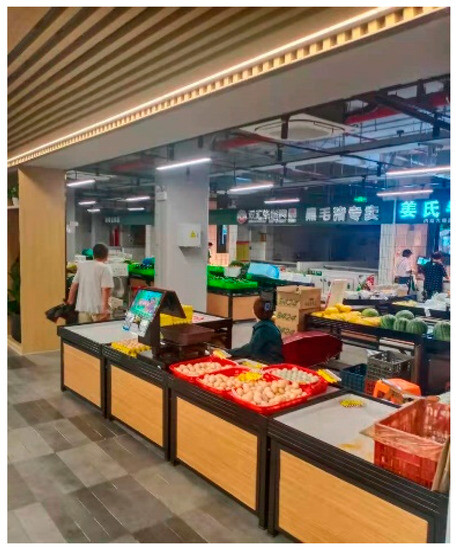
Figure 7.
A community market on Kailua Road in Shanghai.
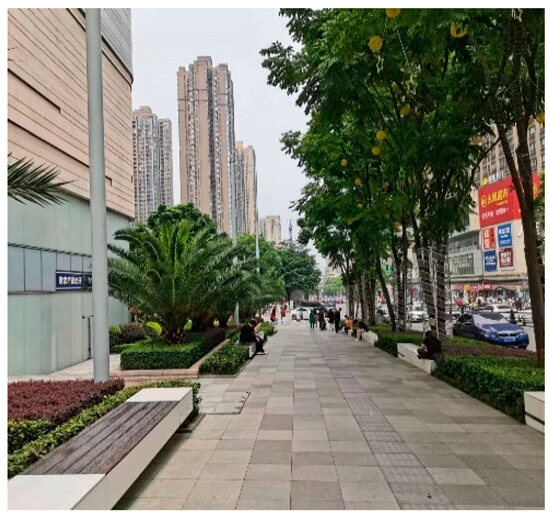
Figure 8.
The Huarun community along a street in Chongqing.
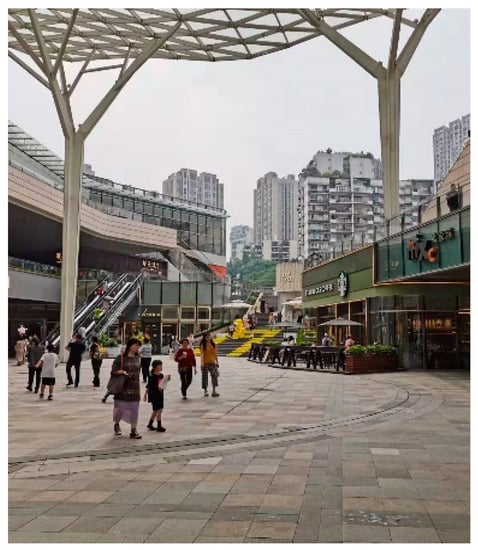
Figure 9.
A mall adjoins the Huarun community in Chongqing.
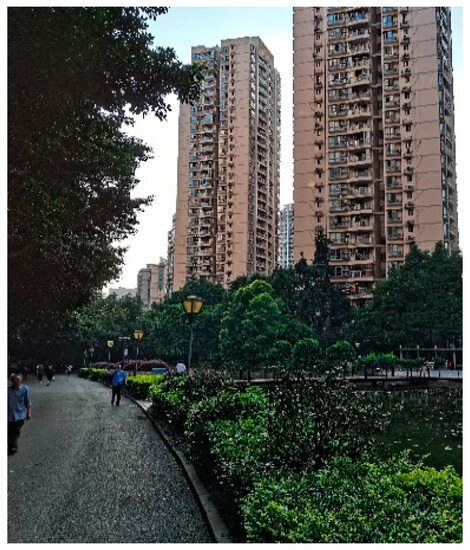
Figure 10.
Public space in the Shanghai-cheng community in Chongqing.
2.3. Data
This paper involves two different sets of data based on the research purpose. In the three cities, the distribution of amenities is crucial to estimate their service availability. Therefore, surveying the distribution of amenities in these districts is a prerequisite for understanding the neighborhood environment. Additionally, investigating the surrounding amenities and living needs in a community is an effective way to assess the suitability of the neighborhood environment. The residential satisfaction of citizens with their living environment can also effectively reflect their level of recognition of the residential surroundings.
Gaode (https://ditu.amap.com/ accessed on 7 March 2021), a Chinese map navigation system, was used to collect data on the coverage and distribution of amenities in large-population cities. The data includes information on the number and location of public facilities or amenities in the three cities. The information covers public institutions, public transport, catering, shopping services, etc.
Moreover, a set of standardized questionnaires was used to collect more data. Investigators randomly selected local residents. The survey was conducted face-to-face with residents of apartment communities in the three cities, and our investigators asked and explained the questions to ensure a consistent approach. This investigation was conducted in three stages. The survey in Shanghai took place from October 2019 to April 2020, while the process in Beijing continued from January to June 2020. Finally, we completed the investigation of Chongqing from January to May 2021.
The survey yielded 1520 questionnaires, of which 1060 (69.7%) were used in this study. A portion of the questionnaire remained incomplete as certain respondents had difficulty identifying the comprised topics. These incomplete questionnaires, deemed unsuitable, were excluded from this study. We collected 445 satisfactory questionnaires in Shanghai, 316 in Beijing, and 299 in Chongqing. Using the Cronbach’s alpha test in Stata, the reliability coefficient of the research variables in this questionnaire was found to be 0.71. This value satisfies the validity criterion (≥0.65). Regarding this survey, the term “neighborhoods” pertains to the areas within a daily walking distance for residents, with a maximum straight-line distance of 2 kilometers. Before inviting participants to complete the questionnaires, the objective of the survey was clearly explained, and all respondents were included in the study voluntarily. Ethical approval was obtained from the respondents, with all participants remaining anonymous. (The research flow chart is included in the Supplementary Materials).
The research questionnaire encompasses three categories of variables: namely, 8 neighborhood amenities, 12 aspects of residents’ lifestyles, and 7 demographic characteristics. Moreover, the dependent variable of residential satisfaction serves as an element for further assessment. The study utilizes a total of 28 variables. The specifics of the questionnaire used are outlined in Table 1 and Table 2.

Table 2.
The demographic characteristics of the respondents.
2.4. Model
According to the purpose, ordered logistic regression is employed to estimate the neighborhood factors and related lifestyles that affect residential satisfaction. An additional analysis was conducted using the ordered probit model to investigate the relationship between the explanatory and dependent variables to enhance the robustness of the survey findings. The statistical calculations were conducted using Stata software. Ordered logistic regression models were applied to ordinal dependent variables and were first considered by McCullagh (1980) [90]. Ordered logistic models estimate relationships between an ordinal dependent variable and a set of independent variables. An ordinal variable is categorical and ordered. The dependent variable (residential satisfaction) is the ordinal dependent variable in this study, and independent variables are eligible for this model. The value of the dependent variable is based on the probability of different categories related to a series of independent variables. The ordered logistic regression model is presented as follows:
assuming that XT = (x1, x2, x3, … xp) reflects the K-ordered variables that compose the evaluation of residential satisfaction. The probability of rank j (j = 1, 2, 3… k) is P(y = j|x); thus, the probability (cumulative probability) of the rank less than j (j = 1, 2, 3… k). Perform logistic transformation on the equation as follows:
This is used to build an ordered logistic regression model, as demonstrated in the following equation:
where P is the cumulative probability and j is the evaluation level. Y is the level of residential satisfaction. X is the independent variables, such as neighborhood elements and daily life factors. N is the number of independent variables; α and β are the constant terms and coefficients, respectively [91]. The ordered probit regression has a similar principle and applicable condition to that of the ordered logistic regression. It is the probability accumulation of the linear combinations of variables.
3. Results
3.1. The Coverage and Distribution of Amenities
To visually represent the amenities of the survey cities, collected POI data is drawn into distribution graphs using kernel density using ArcGIS. The amenities are divided into three categories based on the research subject to effectively express environmental information. Figure 11, Figure 12, Figure 13, Figure 14, Figure 15, Figure 16, Figure 17, Figure 18 and Figure 19 show an intercept image of the survey cities, including the distribution of amenities in the survey areas.

Figure 11.
The distribution of daily service facilities in Beijing.
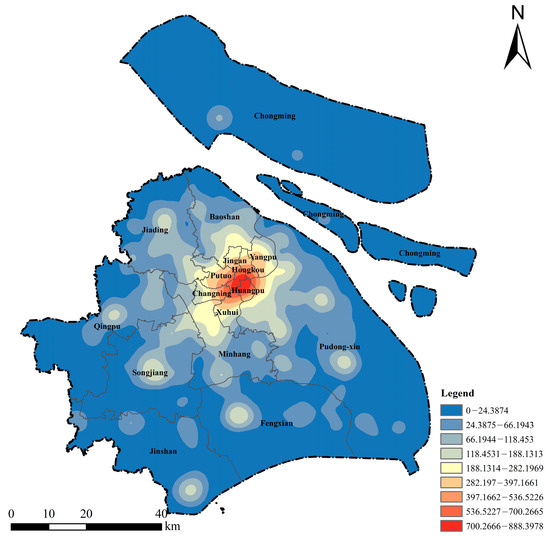
Figure 12.
The distribution of daily service facilities in Shanghai.
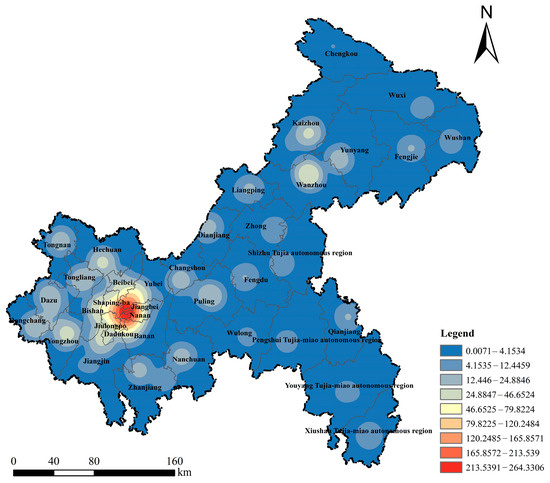
Figure 13.
The distribution of daily service facilities in Chongqing.
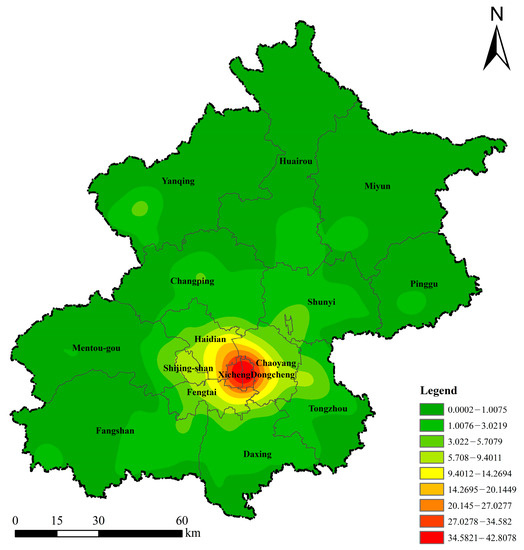
Figure 14.
The distribution of landscape and public institutions in Beijing.

Figure 15.
The distribution of landscape and public institutions in Shanghai.
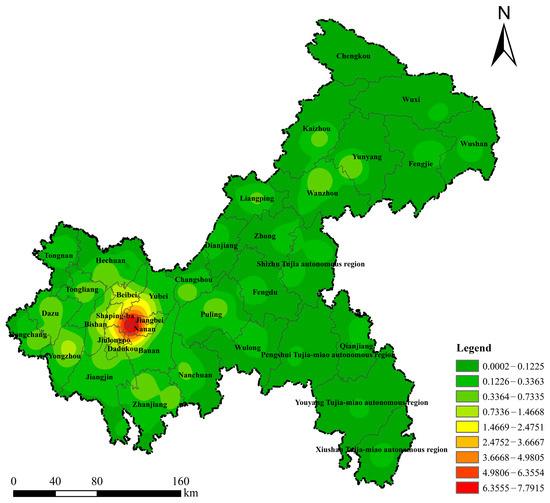
Figure 16.
The distribution of landscape and public institutions in Chongqing.
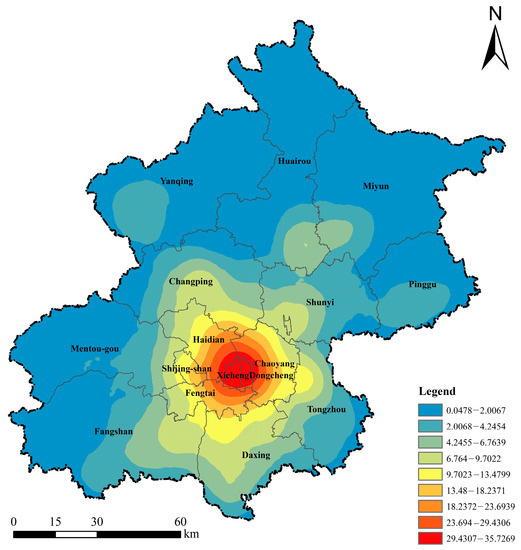
Figure 17.
The distribution of transport services in Beijing.
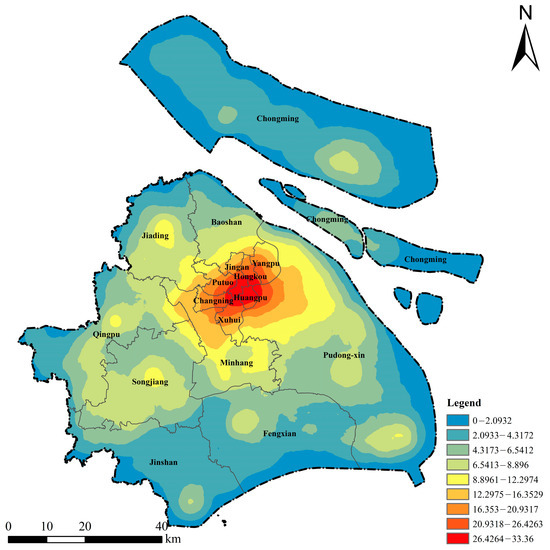
Figure 18.
The distribution of transport services in Shanghai.
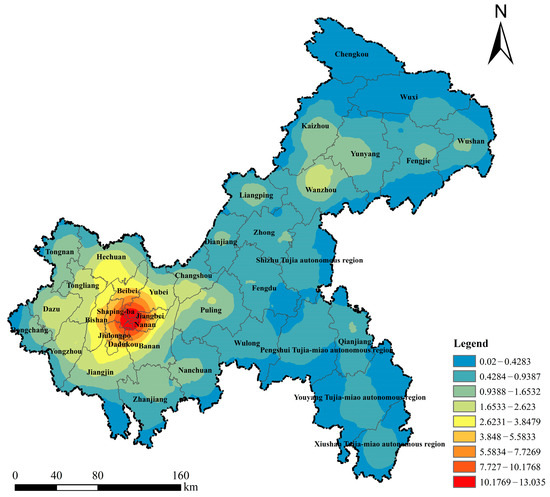
Figure 19.
The distribution of transport services in Chongqing.
Figure 11, Figure 12 and Figure 13 depict the distribution of daily service facilities (markets, catering, and shopping spaces) in the surveyed three cities. A total of nine colors, ranging from red to blue, represent the different levels of point density within a radius of one kilometer. The red areas on the map indicate districts with the highest distribution density, while the blue areas represent the districts with the lowest coverage density. Similarly, Figure 14, Figure 15 and Figure 16 present the landscape and public institution (such as banks and general hospitals) scattergrams of the three densely populated cities surveyed. Green areas represent locations where landscapes and public institutions are sparsely distributed. In contrast, red areas denote the areas with the densest landscape distribution and public institutions. Figure 17, Figure 18 and Figure 19 plot the public transport and road conditions in the three cities. Light blue areas indicate locations with limited public transport and road networks, while areas covered in red indicate areas with better transport connections.
In Beijing, daily service facilities are concentrated in the Dongcheng and Xicheng districts, which also contain numerous political and cultural institutions (Figure 11). Moreover, the Chaoyang, Haidian, and Fengtai districts also have a relatively high distribution of such venues, and these areas are also densely populated. The Jingan and Huangpu districts in Shanghai have the highest distribution ratio and are considered urban centers (Figure 12). The Yuzhong district in Chongqing is the most densely populated, and it also has the highest coverage of daily service facilities, along with the the Jiangbei district (Figure 13). When comparing the three cities, the concentration of daily service facilities in Beijing is obvious. The urban morphology of Beijing can be attributed to a blend of social and historical factors. On one hand, numerous private individuals have established a multitude of stores, as they tend to favor densely populated areas for the sake of higher profits. Consequently, daily service facilities are primarily situated in areas with larger crowds. Moreover, Beijing served as the capital for five Chinese ancient imperial dynasties, which has contributed to its present-day urban layout. As social development and population growth continue, Beijing is gradually expanding beyond its historical urban size. Given the significant number of residents in the old city center, numerous service facilities remain concentrated in this area. In contrast, the neighborhoods within the expanded urban districts provide more spacious settings. Shanghai and Chongqing diverge from Beijing in this aspect. While population density and the number of facilities in central areas still prevail, the distribution of daily service facilities spans numerous regions throughout the city.
The distribution density of landscapes and public institutions is generally lower than that of daily service sites (Figure 14, Figure 15 and Figure 16). Nevertheless, the higher distribution area can also be found in the same sub-districts across the three cities. Moreover, a landscape or public institution can serve the whole community. Due to the unique character of the landscape environment or public institutions, their numbers are considered lower than those for the daily service facilities. After all, landscape and public institutions typically cover larger spatial dimensions to better serve residents.
Based on the density distribution map of transport services, it is evident that the coverage rate of public transportation in the three cities is comparatively more significant (Figure 17, Figure 18 and Figure 19). For instance, the red zone in Beijing extends to the Haidian, Fengtai, and Chaoyang districts (Figure 17). Similarly, the surveyed area in Shanghai is predominantly shown in red and yellow, indicating that the city has excellent public transportation coverage (Figure 18). Chongqing also has a similar situation, with the Beibei, Bishan, Dadukou, and Banan districts having more convenient public transportation systems (Figure 19). These observations highlight that the primary objective of transportation facilities is to serve more people, and they will extend to a growing breadth beyond residential areas. In general, amenities are distributed in the populous subdistricts of the three cities, which could provide adequate and appropriate services for residents. Conversely, urban amenities have the potential to attract a larger number of individuals who opt to reside and thrive in these areas [52].
3.2. Amenities and Lifestyles
This study employed standard questionnaires regarding residential satisfaction to assess whether the availability of amenities caters to daily needs. Table 2 presents the socio-demographic characteristics of the respondents, who ranged in age from their twenties to their seventies. Middle-aged respondents between 30 and 49 comprised half of the total (53.1%). Most respondents (58.6%) were parents who lived with their children, while some were unmarried young people living with their parents. Therefore, families with no fewer than three members accounted for 78.1% of those interviewed. Furthermore, among the respondents, 84.3% had achieved a bachelor’s degree or higher.
This study categorized amenities and lifestyles into nine groups, with correlations based on theoretical knowledge and listed variables (Table 3). Each variable group examined residents’ lifestyles and the corresponding amenities. The test results were obtained using Kendall’s tau-b correlation analysis due to the ordinal variables.

Table 3.
The Kendall’s tau-b correlation analysis.
The findings demonstrate a strong correlation between transport services and commuting time, as well as between parking capacity and commuting methods (p < 0.001). The presence of green spaces in residential areas is positively associated with the frequency of outdoor exercise among residents. Furthermore, the outdoor activity spaces affect residents’ fitness habits (p < 0.001). The number of public institutions (such as banks, hospitals, and libraries) also statistically correlates with the residents’ income management ratio. Residents with a high need for security tend to choose communities with robust security services (p < 0.001). In Chinese metropolises, business districts often have numerous restaurants, which attracts residents in proximity to these areas (p < 0.1). Education plays a crucial role in residents’ decision to choose a school district as their place of residence.
The results indicate a statistically significant relationship between amenities and daily life. Multiple lifestyles correlate with amenities in neighborhoods. The amenities surrounding the community are designed to cater to the daily needs of the residents, to the best of their ability.
3.3. The Determinants of Residential Satisfaction
Post-occupancy evaluation is a crucial method for assessing the habitability of residential areas. In the 1960s, residential satisfaction became the standard for post-occupancy evaluation to optimize and improve community planning [92]. Understanding the factors that significantly affect residential satisfaction is essential for assessing the livability of neighborhoods and the well-being of residents. This study analyzes the interrelationship between amenities and lifestyles and its impact on residential satisfaction from two group variables and further evaluates the actual status of these factors.
The residence evaluation can be influenced by demographic characteristics [93]. Therefore, incorporating additional variables becomes crucial for assessing the robustness of the model. This study divided ordered logistic regressions into two groups (Table 4). The first group, ordered logistic1, examines the impact of amenities on residential satisfaction. The second group, ordered logistic2, incorporates demographic factors.

Table 4.
Residential satisfaction and amenities in neighborhoods.
Considering that marital status [94] and educational level [84] could alter residents’ living conditions and expectations regarding the living environment, they were included as control variables. These two variables play a significant role in influencing residents’ living preferences. Furthermore, the presence of children in a household significantly affects the importance placed on school districts. Thus, the variable indicating whether residents live with children [38] was also included in ordered logistic2.
Notably, the regression results of the three groups (Table 4—ordered logistic 1, ordered logistic 2, ordered probit) consistently highlight the same neighborhood factors significantly impacting residential satisfaction.
Among these, the transport services and road networks are critical factors that affect residents’ daily lives. Public transportation modes, such as buses and subways [95], play a vital role in saving time during daily commutes to the workplace or city center, which, in turn, can influence residents’ subjective evaluations and experiences regarding their neighborhoods [96].
When residents can easily access public transportation stations by foot and use them to travel to various locations in the city, their daily commutes become significantly more convenient (p < 0.1). However, traffic jams in the streets or remote areas with low accessibility can cause significant inconvenience during daily travel [28,95].
The parking capacity is an essential driver consideration and can indirectly affect travel convenience (p < 0.001). To address this, the project site-planning concepts should include car parking and garbage disposal areas [31]. High-capacity parking has a positive effect on daily life. Additionally, landscape and green space (p < 0.001) are factors that enhance the usability of neighborhoods for relaxation, social gatherings, outdoor exercise, and child play areas [7,79].
Security is a critical factor in social environments. People require social interaction, but high crime rates can threaten their personal safety and diminish their quality of life [16]. Thus, a safe living environment is particularly crucial in densely populated areas where diverse crowds gather, leading to increased potential threats [28]. Public institutions also play a crucial role in citizens’ daily lives, supporting the essential services required to meet residents’ life demands (p < 0.001).
Table 5 lists the daily lives and demands that affect residential satisfaction. Table 6 presents the order logistic and probit regressions outcomes, which incorporated demographic characteristics as control variables in examining lifestyle factors. In this series of tests, the observation variable focused on lifestyle, while the additional demographic factors included income, educational level, and the presence of children in the household.

Table 5.
Residential satisfaction and daily life.

Table 6.
Residential satisfaction and daily life using demographic characteristics.
As suggested by Dwira et al. [67,97,98], wages can help to distinguish the living habits and residential preferences of residents and ultimately impact residential satisfaction. Thus, the monthly wage was included as a control variable in this specific set of tests.
The findings in Table 6 indicate that the investment factor does not significantly impact residential satisfaction, while monthly wage exhibits a clear and statistically significant influence (p < 0.001). Based on these observed characteristics, it is suspected that monthly wages may be endogenous. To address this concern, the CMP two-step method is employed to identify additional variables that can replace monthly wage to further evaluate the model (Table 7).

Table 7.
The result of endogeneity estimation.
The first step measures various demographic characteristics as potential instrumental variables. The results reveal a strong correlation between marital status and monthly wage, making marital status a suitable candidate as an instrumental variable. Moving to the second step, the parameter Atanhrho_12 is non-zero, suggesting the need for introducing the variables of marital status in the subsequent estimation process.
Table 8 presents the detection results of the CMP-ordered probit model that the lifestyle factors statistically significantly impact residential satisfaction. In Table 5 and Table 8, five items have positive and significant impacts on residential satisfaction. Commuting methods, which relate to transport convenience and residential location, are crucial factors [99]. The choice of a commuting method for residents depends on the transport services in their neighborhoods. In the correlation test (Table 3), the commuting method shows a statistical relationship with parking capacity. In cases where public transportation is inconvenient, residents opt for driving. In such scenarios, residents who choose to drive a car need to pay more attention to the availability and convenience of parking.

Table 8.
CMP-ordered probit of residential satisfaction and daily life.
The frequency of outdoor exercise (p < 0.1) is statistically correlated with the presence of green spaces (Table 3), making them a popular destination for leisure time among residents. This is why green spaces are a matter of concern for most people. Despite the statistical correlation between school districts and the importance of education (Table 3), Table 4 shows that school districts are not a significant factor in determining residential satisfaction. There may be three reasons for this: many residents only consider purchasing a home in a school zone if they have school-age children. Although they highly value education, they might hesitate due to the expensive housing costs in specific school districts. Additionally, in the set of variables (Table 4), the impact of the school district on residential satisfaction might be weakened by other neighborhood factors.
Citizens with a higher degree of financial security or better financial management tend to report higher levels of residential satisfaction (Table 5). This factor is supported by the statistical correlation between investment and public institutions, as shown in Table 3, which suggests that families with good economic conditions are more likely to value social services provided by such institutions. Citizens place great importance on security and safety precautions, which can significantly impact their evaluation of residential areas (Table 5).
The findings of this study indicate a higher availability of amenities in densely populated urban areas. This situation underscores the interconnection between urban facility planning, neighborhood construction, and the requirements of citizens. Furthermore, by considering residents’ lifestyles and their frequency of utilizing these facilities, it becomes evident that amenities exhibit a statistically significant correlation with the everyday needs of inhabitants. The outcomes of the regression analysis provide additional confirmation that ample and diverse amenities exert a positive influence on residents’ satisfaction with their neighborhoods. Simultaneously, amenities cater to the daily lifestyles of residents, which emerge as a primary determinant in their residential assessments. Based on the descriptions provided above, the amenities within residential areas are intricately intertwined with urban life, playing a pivotal role in enhancing the quality of life for residents.
4. Discussion
4.1. Research Scope and Comparison
Based on the assessment of the coverage of these aspects, the survey findings indicate that service facilities are widely distributed in densely populated areas. These compact areas are located in the center of cities as age-old districts. On one hand, they possess a sizable original population, and citizens also prefer selecting locales with abundant amenities for their residences [45]. As per the report of the 20th CPC National Congress (2022), the primary objective of future development is to establish comprehensive residential communities that are secure, sustainable, well-equipped, and efficiently managed [100]. Urban amenities must cater to the everyday requirements of citizens. The development of such amenities will inevitably expand and gradually be constructed in conjunction with population growth [101]. The coverage of public transportation is relatively extensive, and both roads and public transportation systems can reach greater distances in the three surveyed cities. Inadequate transportation infrastructure can erect barriers to economic development, personal mobility, and business interactions. Even in distant regions, travel hindrances can significantly impact residents’ abilities to meet their fundamental needs [102].
Although previous studies have acknowledged the associations between residents’ lifestyles and their diverse residential demands [67,103], less research has been done to identify which amenities effectively cater to residents’ specific daily activities. According to the demands of daily living, citizens require access to public transportation to facilitate their daily commutes. This finding aligns with previous research conducted by Ji and Gao (2010) [95], as well as other scholars [104]. Furthermore, with the growing popularity of car travel, the need for parking facilities among residents has become more pronounced. Citizens also engage in outdoor activities, and providing green spaces can satisfy this need. At the same time, a well-designed landscape can improve the ecological and microclimatic conditions of the region [105]. It is worth noting that residing within a school district may be considered a positive factor [63], particularly for families with school-age children who prioritize this aspect even more. Public institutions can offer convenience to individuals who actively manage their household income. Citizens interested in investment and financial management have more opportunities to engage with urban public institutions and consume their services. Meanwhile, security plays a vital role in densely populated residential areas [106]. Security services can actively enhance the residential experience for residents, with the willingness of Chinese citizens in populous cities to opt for gated communities to ensure security and their readiness to pay associated fees for this service.
4.2. Significance of the Research
Admittedly, residents’ daily needs display diversity. The availability of adequate and varied amenities within walking distance in neighborhoods is pivotal for upholding the convenience of residents’ daily routines. These amenities play a vital role in delivering enhanced social services to the majority of residents. By effectively meeting citizens’ everyday requirements, these facilities contribute to increased residential satisfaction and consequently, to an elevated sense of overall life contentment.
This research has yielded valuable insights in light of the prevailing conditions in densely populated cities in China. It reveals that an ideal neighborhood should encompass several key features: easy access to public transportation for commuting purposes; the presence of green spaces for recreational activities; effective security management; and public institutions that cater to residents’ daily requirements. Another valuable piece of information from this study is that the effectiveness of those amenities is reflected not only in their quantity and location, but also in how they effectively satisfy the social aspects of citizens’ lives, particularly in densely populated residential areas. In a strategy of urban sustainable development, a walkable surrounding environment with suitable amenities can enhance facility utilization and decrease automobile usage, ultimately leading to waste and pollution reduction [49].
4.3. Limitations and Future Directions
The study has several limitations that should be acknowledged. First, face-to-face investigation methods were intended to ensure professionalism and consistency in the survey process. However, this decision resulted in slower progress of the survey, which in turn, affected the sample size. Owing to the omission of cities like Hangzhou, Nanjing, and Guangzhou from the survey, capturing a comprehensive overview of China’s situation through this study becomes challenging. Furthermore, due to the mobility of the population and limitations in community management, it was not feasible to obtain detailed population data for each residential area during the survey period. Another limitation of this survey is the potential influence of respondents’ emotions on the results. To maintain objectivity, the survey focused on quantifying the frequency of daily activities related to lifestyle factors, excluding certain emotional aspects. However, personal moods will more or less affect the feelings of the residents about their residential environment and could also form some potential group tendencies.
In future investigations, the researchers aim to address these limitations by enriching the available data and optimizing the research content and structure. These adjustments will contribute to a more comprehensive understanding of the subject matter.
5. Conclusions
Because of the increase in the urban population, the residential pattern of the cities in China underwent a partial transformation from medium-density multi-story buildings in the early 1980s to high-density high-rise structures after the 2010s [26]. To align with the goals of sustainable development, the implementation of a compact land policy has been proven effective in curbing urban expansion, while enhancing the scope and efficiency of facility alliance-building [107]. Furthermore, considering the lifestyles and demands of residents [6] and providing convenient facilities that cater to the daily needs of residents has a positive impact on the long-term enhancement of urban public service quality.
Implementing compact, convenient, and centralized residential districts accords with the principles of new urbanism, leading to reduced energy consumption and the improved efficiency of urban services. Furthermore, compact land use promotes the availability of diverse amenities and services, thereby positively influencing the development strategies of the three cities. Adopting a compact settlement model can effectively mitigate urban sprawl in Beijing and contribute to maintaining a pleasant neighborhood atmosphere. Following the urban development needs, the overall planning approach in Shanghai and Chongqing is progressively evolving into a multiple nuclei model, which is justifiable for a province-level city like Chongqing. The core factor for the stable development of the area is the optimization of facilities within the block [108]. Government departments can regulate and plan adequate amenities, allowing for regional development adjustments or stimulation, based on such provisions.
This study presents significant contributions to the development of residential areas in densely populated cities, with positive implications for real estate development. Investing in high-density areas proves to be more efficient and cost-effective, resulting in potential advantages for residents in populous cities. The concentration of the population in these areas also promotes the rapid development of the local core, thereby enhancing the utilization of limited financial resources. In the transformation of the urban configuration, neighborhoods with essential amenities can facilitate and drive urban regional development by providing effective services. This feature is essential in governmental efforts aimed at reducing energy consumption and improving the quality of life. Moreover, these positive efforts align well with sustainable urban goals.
Supplementary Materials
The following supporting information can be downloaded at: https://www.mdpi.com/article/10.3390/su151713255/s1, Table S1: The details of the socio-demographic characteristics. Figure S1: The research flow chart.
Author Contributions
Conceptualization, K.Z. and D.Y.; methodology, K.Z.; validation, D.Y. and K.Z.; investigation, D.Y.; resources, D.Y.; data curation, K.Z.; writing—original draft preparation, K.Z.; writing—review and editing, K.Z.; visualization, K.Z.; funding acquisition, K.Z. All authors have read and agreed to the published version of the manuscript.
Funding
This research was funded by the scientific research fund of Chongqing University of Posts and Telecommunications, grant number K2021-175, and the Social Science Project of the Chongqing Municipal Education Commission, grant number 22SKGH154.
Institutional Review Board Statement
Not applicable for studies not involving humans or animals.
Informed Consent Statement
Informed consent was obtained from all subjects involved in the study.
Data Availability Statement
The data presented in this study are available upon request from the authors.
Conflicts of Interest
The authors declare no conflict of interest.
References
- State Bureau Statistics-The Seventh Census Report. The State Council of the People’s Republic of China. Available online: https://www.gov.cn/guoqing/2021-05/13/content_5606149.htm (accessed on 5 November 2021).
- Flynn, A.; Yu, L.; Feindt, P.; Chen, C. Eco-cities, governance, and sustainable lifestyles: The case of the Sino-Singapore Tianjin Eco-City. Habitat Int. 2016, 53, 78–86. [Google Scholar] [CrossRef]
- Ding, C.; Li, Z. City Size and Household Consumption in China. Land 2022, 11, 2027. [Google Scholar] [CrossRef]
- Mouratidis, K. Urban planning and quality of life: A review of pathways linking the built environment to subjective well-being. Cities 2021, 115, 103229. [Google Scholar] [CrossRef]
- Ding, X.; Cai, Z.; Fu, Z. Does the new-type urbanization construction improve the efficiency of agricultural green water utilization in the Yangtze River Economic Belt? Environ. Sci. Pollut. Res. 2021, 28, 64103–64112. [Google Scholar] [CrossRef] [PubMed]
- Naess, P. Urban Planning and Sustainable Development. Eur. Plan. Stud. 2001, 9, 503–524. [Google Scholar] [CrossRef]
- Huang, S.C.L. A study of outdoor interactional spaces in high-rise housing. Landsc. Urban Plan. 2006, 78, 193–204. [Google Scholar] [CrossRef]
- Development Ministry of Housing and Urban-Rural-The Fourteenth Five-Year Plan. The State Council of the People’s Republic of China. Available online: https://www.gov.cn/zhengce/zhengceku/2022-07/31/content_5703690.htm (accessed on 18 July 2023).
- Song, Y.; Zhou, J.; Zhang, Y.; Wu, D.; Xu, H. How Much Are Amenities Worth? An Empirical Study on Urban Land and Housing Price Differentials across Chinese Cities. Land 2022, 11, 916. [Google Scholar] [CrossRef]
- Cattell, V.; Dines, N.; Gesler, W.; Curtis, S. Mingling, observing, and lingering: Everyday public spaces and their implications for well-being and social relations. Health Place 2008, 14, 544–561. [Google Scholar] [CrossRef]
- Baig, F.; Rana, I.A.; Talpur, M.A.H. Determining Factors Influencing Residents’ Satisfaction Regarding Urban Livability in Pakistan. Int. J. Community Well-Being 2019, 2, 91–110. [Google Scholar] [CrossRef]
- Savasdisara, T. Resident’s satisfaction and neighbourhood characteristics in Japanese urban communities. Landsc. Urban Plan. 1988, 15, 201–210. [Google Scholar] [CrossRef]
- Kostas, M.; Andersen, B. What makes people stay longer in the densifying city? Exploring the neighbourhood environment and social ties. Hous. Stud. 2023. [Google Scholar] [CrossRef]
- Wijesundara, J.; Weerasinghe, U.G.D.; Perera, L.S.R. Inhabitants’ Satisfaction in Neighbourhood Sustainability: Insights from Colombo. J. Int. Soc. Study Vernac. Settl. 2021, 8, 64–76. [Google Scholar]
- Mridha, A.M.M.H.; Moore, G.T. The Quality of Life in Dhaka, Bangladesh: Neighborhood Quality as a Major Component of Residential Satisfaction. Investig. Qual. Urban Life 2011, 45, 251–272. [Google Scholar]
- Swaroop, S.; Krysan, M. The determinants of neighborhood satisfaction: Racialroxy revisited. Demography 2011, 48, 1203–1229. [Google Scholar] [CrossRef]
- Scott, C.B.; Joanna, L.L. Neighborhoods and Social Interaction. In Wellbeing and the Environment; John Wiley & Sons, Ltd.: Hoboken, NJ, USA, 2014; Volume II, pp. 91–118. [Google Scholar]
- Ma, J.; Dong, G.; Chen, Y.; Zhang, W. Does satisfactory neighbourhood environment lead to a satisfying life? An investigation of the association between neighbourhood environment and life satisfaction in Beijing. Cities 2018, 74, 229–239. [Google Scholar] [CrossRef]
- Michell, K. Urban facilities management: A means to the attainment of sustainable cities? J. Facil. Manag. 2013, 11, 3. [Google Scholar] [CrossRef]
- Choguill, C.L. Developing sustainable neighbourhoods. Habitat Int. 2008, 32, 41–48. [Google Scholar] [CrossRef]
- Özcan, K.; Eren, F. A study on the future of urban models in the third millennium: A sustainable urban model for Kırıkkale, Turkey. Sustain. City IV Urban Regen. Sustain. 2006, 93, 367–375. [Google Scholar]
- Rahman, M.S.; Hussain, B.; Uddin, A.M.; Islam, N. Exploring residents’ satisfaction of facilities provided by private apartment companies. Asia Pac. Manag. Rev. 2015, 20, 130–140. [Google Scholar] [CrossRef]
- O’Campo, P.; Salmon, C.; Burke, J. Neighbourhoods and mental well-being: What are the pathways? Health Place 2008, 15, 56–68. [Google Scholar] [CrossRef]
- Lee, J.; Je, H.; Byun, J. Well-Being index of super tall residential buildings in Korea. Build. Environ. 2011, 46, 1184–1194. [Google Scholar] [CrossRef]
- Alexander, J.W. The basic-nonbasic concept of urban economic functions. Econ. Geogr. 1954, 30, 246–261. [Google Scholar] [CrossRef]
- Chen, J.; Pellegrini, P.; Xu, Y.; Ma, G.; Wang, H.; an, Y.; Shi, Y.; Feng, X. Evaluating residents’ satisfaction before and after regeneration. The case of a high-density resettlement neighbourhood in Suzhou, China. Cogent Soc. Sci. 2022, 8, 2144137. [Google Scholar] [CrossRef]
- Burton, E. The potential of the compact city for promoting social equity. In Achieving Sustainable Urban Form, 2nd ed.; Burton, E., William, K., Jenks, M., Eds.; Routledge: New York, NY, USA, 2001; pp. 19–30. [Google Scholar]
- Wang, D.; Wang, F. Contributions of the Usage and Affective Experience of the Residential Environment to Residential Satisfaction. Hous. Stud. 2016, 31, 42–60. [Google Scholar] [CrossRef]
- Qureshi, S.; Memon, I.A.; Talpur, M.A.H. Association between Objectively Measured Neighbourhood Built Environment and Walkability. Mehran Univ. Res. J. Eng. Technol. 2022, 41, 157–168. [Google Scholar] [CrossRef]
- Wang, F.; Wang, D. Changes in residential satisfaction after home relocation: A longitudinal study in Beijing, China. Urban Study 2019, 57, 583–601. [Google Scholar] [CrossRef]
- Kowaltowski, D.C.; da Silva, V.G.; Pina, S.A.; Labaki, L.C.; Ruschel, R.C.; de Carvalho Moreira, D. Quality of life and sustainability issues as seen by the population of low-income housing in the region of Campinas, Brazil. Habitat Int. 2006, 30, 1100–1114. [Google Scholar] [CrossRef]
- Franco, S.F.; Cutter, W.B. The determinants of non-residential real estate values with special reference to environmental local amenities. Ecol. Econ. 2022, 201, 107485. [Google Scholar] [CrossRef]
- Waverijn, G.; Groenewegen, P.P.; de Klerk, M. Social capital, collective efficacy and the provision of social support services and amenities by municipalities in the Netherlands. Health Soc. Care Community 2017, 25, 414–423. [Google Scholar] [CrossRef]
- Allen, N. Understanding the Importance of Urban Amenities: A Case Study from Auckland. Buildings 2015, 5, 85–99. [Google Scholar] [CrossRef]
- Toll, K.; Caplan, A.J.; Akhundjanov, S.B. Measuring heterogeneous preferences for residential amenities. Reg. Sci. Urban Econ. 2021, 87, 103646. [Google Scholar]
- Ströbele, M.; Hunziker, M. Are suburbs perceived as rural villages? Landscape-related residential preferences in Switzerland. Landsc. Urban Plan. 2017, 163, 67–79. [Google Scholar] [CrossRef]
- Choi, K.; Park, H.J.; Dewald, J. The impact of mixes of transportation options on residential property values: Synergistic effects of walkability. Cities 2021, 111, 103080. [Google Scholar] [CrossRef]
- Wen, H.; Xiao, Y.; Zhang, L. School district, education quality, and housing price: Evidence from a natural experiment in Hangzhou, China. Cities 2017, 66, 72–80. [Google Scholar] [CrossRef]
- Barros, P.; Mehta, V.; Brindley, P.; Zandieh, R. The restorative potential of commercial streets. Landsc. Res. 2021, 46, 1017–1037. [Google Scholar] [CrossRef]
- Zou, W.; Li, J.; Shu, Z. Urban Quality of Life and Production Amenity in Chinese Cities. Sustainability 2022, 14, 2434. [Google Scholar] [CrossRef]
- Wang, Y.; Shaw, D.; Yuan, K. Gated Neighborhoods, Privatized Amenities and Fragmented Society: Evidence from Residential Experience and Implications for Urban Planning. Sustainability 2018, 10, 4301. [Google Scholar] [CrossRef]
- Yu, Z.; Zhang, H.; Tao, Z.; Liang, J. Amenities, economic opportunities and patterns of migration at the city level in China. Asian Pac. Migr. J. 2019, 28, 3–27. [Google Scholar] [CrossRef]
- Pishgahi, S.; Partovi, P. Evaluating the effects of cross-neighborhood facilities on residential satisfaction by developing importance-satisfaction rate method (case study: Jahanshahr neighborhood of Karaj, Iran). J. Hous. Built Environ. 2021, 36, 453–486. [Google Scholar] [CrossRef]
- Yin, R.; Miao, X.; Geng, Z.; Sun, Y. Assessment of Residential Satisfaction and Influence Mechanism—A Case Study of Jinan City. J. Bus. Adm. Res. 2018, 7, 9–16. [Google Scholar] [CrossRef]
- Huang, Z.; Du, X. Assessment and determinants of residential satisfaction with public housing in Hangzhou, China. Habitat Int. 2015, 47, 218–230. [Google Scholar] [CrossRef]
- Lu, M. Determinants of Residential Satisfaction: Ordered Logit vs. Regression Models. Growth Change A J. Urban Reg. Policy 2002, 30, 264–287. [Google Scholar] [CrossRef]
- James, R.N.; Carswell, A.T.; Sweaney, A.L. Sources of Discontent: Residential Satisfaction of Tenants From an Internet Ratings Site. Environ. Behav. 2008, 41, 43–59. [Google Scholar] [CrossRef]
- Zasina, J.; Antczak, E. The ‘gown’ unconcerned with the town? Residential satisfaction of university students living in off-campus private accommodation. Hous. Stud. 2021, 31, 1536–1559. [Google Scholar] [CrossRef]
- Wheeler, S.M. Planning for Metropolitan Sustainability. J. Plan. Educ. Res. 2000, 20, 133–145. [Google Scholar] [CrossRef]
- Sirgy, M.J.; Cornwell, T. How neighborhood features affect quality of life. Soc. Indic. Res. 2002, 59, 79–114. [Google Scholar] [CrossRef]
- Duff, C. Networks, resources and agencies: On the character and production of enabling places. Health Place 2011, 17, 149–156. [Google Scholar] [CrossRef]
- Ren, Q.; Ni, J.; Li, H.; Mao, G.; Hsu, W.L.; Yang, J. Analysis on Spatial Characteristics of Supply–Demand Relationship of Amenities in Expanding Central Urban Areas—A Case Study of Huai’an, China. Land 2022, 11, 1137. [Google Scholar] [CrossRef]
- Hur, M.; Morrow-Jones, H. Factors that influence residents’ satisfaction with neighborhoods. Environ. Behav. 2008, 40, 619–635. [Google Scholar] [CrossRef]
- Tong, D.; Zhang, Y.; MacLachlan, I.; Li, G. Migrant housing choices from a social capital perspective: The case of Shenzhen, China. Habitat Int. 2020, 96, 102082. [Google Scholar] [CrossRef]
- Talpur, M.A.H.; Napiah, M.; Chandio, I.; Khahro, S.H. Transportation Planning Survey Methodologies for the Proposed Study of Physical and Socio-economic Development of Deprived Rural Regions: A Review. Mod. Appl. Sci. 2012, 6, 2–17. [Google Scholar] [CrossRef]
- Weckroth, M.; Ala-Mantila, S.; Ballas, D.; Ziogas, T.; Ikonen, J. Urbanity, Neighbourhood Characteristics and Perceived Quality of Life (QoL): Analysis of Individual and Contextual Determinants for Perceived QoL in 3300 Postal Code Areas in Finland. Soc. Indic. Res. 2022, 164, 139–164. [Google Scholar] [CrossRef]
- Lilius, J. Is There room for families in the inner city? life-stage blenders challenging planning. Hous. Stud. 2014, 29, 843–861. [Google Scholar] [CrossRef]
- Hatuka, T.; Zur, H.; Mendoza, A.J. The urban digital lifestyle: An analytical framework for placing digital practices in a spatial context and for developing applicable policy. Cities 2021, 111, 102978. [Google Scholar] [CrossRef]
- Pfeiffer, D.; Cloutier, S. Planning for happy neighborhoods. J. Am. Plan. Assoc. 2016, 82, 267–279. [Google Scholar] [CrossRef]
- Türkoğlu, H.; Terzi, F.; Salihoğlu, T.; Bölen, F.; Okumuş, G. Residential satisfaction in formal and informal neighborhoods: The case of Istanbul, Turkey. J. Archit. Res. 2019, 13, 112–132. [Google Scholar] [CrossRef]
- Rioux, L.; Werner, C. Residential satisfaction among aging people living in place. J. Environ. Psychol. 2011, 31, 158–169. [Google Scholar] [CrossRef]
- Cardone, B.; D’Ambrosio, V.; Di Martino, F.; Miraglia, V.; Rigillo, M. Analysis of the Ecological Efficiency Increase of Urban Green Areas in Densely Populated Cities. Land 2023, 12, 523. [Google Scholar] [CrossRef]
- Xu, Y.; Song, W.; Liu, C. Social-Spatial Accessibility to Urban Educational Resources under the School District System: A Case Study of Public Primary Schools in Nanjing, China. Sustainability 2018, 10, 2305. [Google Scholar] [CrossRef]
- Tsang, M.C. Financial reform of basic education in China. Econ. Educ. Rev. 1996, 15, 423–444. [Google Scholar] [CrossRef]
- Mohit, M.A.; Ibrahimand, M.; Rashid, Y.R. Assessment of residential satisfaction in newly designed public low-cost housing in Kuala Lumpur, Malaysia. Habitat Int. 2010, 34, 18–27. [Google Scholar] [CrossRef]
- Christiansen, P.O. Culture and Scontrasts in a northern European village: Lifestyles among manoral peasants in 18th.century Denmark. J. Soc. Hist. 1995, 29, 275–294. [Google Scholar] [CrossRef]
- Ge, J.; Hokao, K. Research on residential lifestyles in Japanese cities from the viewpoints of residential preference, residential choice and residential satisfaction. Landsc. Urban Plan. 2006, 78, 165–178. [Google Scholar] [CrossRef]
- Krieseand, U.; Scholz, R.W. Lifestyle Ideas of House Builders and Housing Investors. Hous. Theory Soc. 2011, 29, 288–320. [Google Scholar] [CrossRef]
- Sirgy, M.J. Residential Well-Being. Psychol. Qual. Life 2012, 50, 303–324. [Google Scholar]
- Frenkel, A.; Bendit, E.; Kaplan, S. Residential location choice of knowledge-workers: The role of amenities, workplace and lifestyle. Cities 2013, 35, 33–41. [Google Scholar] [CrossRef]
- Morris, A.E.; Guerra, E. Are we there yet? Trip duration and mood during travel. Transp. Res. Part F Traffic Psychol. Behav. 2015, 33, 38–47. [Google Scholar] [CrossRef]
- Morrison, P.S. Local expressions of subjective well-being: The New Zealand experience. Reg. Stud. 2011, 45, 1039–1058. [Google Scholar] [CrossRef]
- Sun, Z.; Scott, I.; Bell, S.; Zhang, X.; Wang, L. Time Distances to Residential Food Amenities and Daily Walking Duration: A Cross-Sectional Study in Two Low Tier Chinese Cities. Int. J. Environ. Res. Public Health 2021, 18, 839. [Google Scholar] [CrossRef]
- Hribernik, J.; Mussap, A.J. Research note: Leisure satisfaction and subjective wellbeing. Ann. Leis. Res. 2010, 13, 701–708. [Google Scholar] [CrossRef]
- Liu, H. Personality, leisure satisfaction, and subjective well-being of serious leisure participants. Soc. Behav. Personal. Int. J. 2014, 42, 1117–1125. [Google Scholar] [CrossRef]
- Phillips, D.R.; Siu, O.L.; Yeh, A.G.; Cheng, K.H. Factors influencing older persons’ residential satisfaction in big and densely populated cities in Asia: A case study in HONG KONG. Aging Int. 2004, 29, 46–70. [Google Scholar] [CrossRef]
- Teck-Hong, T. Housing satisfaction in medium- and high-cost housing: The case of Greater Kuala Lumpur, Malaysia. Habitat Int. 2012, 36, 108–116. [Google Scholar] [CrossRef]
- Leslie, E.; Sugiyama, T.; Ierodiaconou, D.; Kremer, P. Perceived and Objectively Measured Greenness of Neighbourhoods: Are They Measuring the Same Thing? Landsc. Urban Plan. 2010, 95, 28–33. [Google Scholar] [CrossRef]
- Bonaiuto, M.; Bonnes, M.; Continisio, M. Neighborhood evaluation with a multiplace perspective on urban activities. Environ. Behav. 2004, 36, 41–69. [Google Scholar] [CrossRef]
- Bonaiuto, M.; Fornara, F.; Bonnes, M. Indexes of perceived residential environment quality and neighbourhood attachment in urban environments: A confirmation study on the city of Rome. Landsc. Urban Plan. 2003, 65, 41–52. [Google Scholar] [CrossRef]
- Ergeneli, A.; Arı, G.S.; Metin, S. Psychological empowerment and its relationship to trust in immediate managers. J. Bus. Res. 2007, 60, 41–49. [Google Scholar] [CrossRef]
- Bernerth, J.B.; Aguinis, H. A Critical Review and Best-Practice Recommendations for Control Variable Usage. Pers. Psychol. 2016, 69, 229–283. [Google Scholar] [CrossRef]
- Lu, M. ‘Are pastures greener?’ Residential consequences of migration. Int. J. Popul. Geogr. 2022, 8, 201–216. [Google Scholar] [CrossRef]
- Li, J.; Li, D.; Ning, X.; Sun, J.; Du, H. Residential satisfaction among resettled tenants in public rental housing in Wuhan, China. J. Hous. Built Environ. 2019, 34, 1125–1148. [Google Scholar] [CrossRef]
- The Announcement of the 7th National Census. National Bureau of Statistics of China. Available online: http://www.stats.gov.cn/tjsj/zxfb/202105/t20210510_1817179.html (accessed on 20 December 2021).
- Feng, C.; Zhang, H.; Xiao, L.; Guo, Y. Land Use Change and Its Driving Factors in the Rural–Urban Fringe of Beijing: A Production–Living–Ecological Perspective. Land 2022, 11, 314. [Google Scholar] [CrossRef]
- Xu, J.; Liao, B.; Shen, Q.; Zhang, F.; Mei, A. Urban Spatial Restructuring in Transitional Economy —Changing Land Use Pattern in Shanghai. Chin. Geogr. Sci. 2007, 17, 019–027. [Google Scholar] [CrossRef]
- Zhang, L.; Wang, Z.; Da, L. Spatial characteristics of urban green space: A case study of Shanghai, China. Appl. Ecol. Environ. Res. 2019, 17, 1799–1851. [Google Scholar] [CrossRef]
- Hidalgo Martinez, M.; Cartier, C. City as Province in China: The Territorial Urbanization of Chongqing. Eurasian Geogr. Econ. 2017, 28, 201–230. [Google Scholar] [CrossRef]
- McCullagh, P. Regression Models for Ordinal Data. J. R. Stat. Soc. Ser. B (Methodol.) 1980, 42, 109–127. [Google Scholar] [CrossRef]
- Hu, J.W.; Javaid, A.; Creutzig, F. Leverage points for accelerating adoption of shared electric cars: Perceived benefits and environmental impact of NEVs. Energy Policy 2021, 155, 112349. [Google Scholar] [CrossRef]
- Mohit, M.A.; Azim, M. Assessment of residential satisfaction with public housing in Hulhumale’, Maldives. Procedia-Soc. Behav. Sci. 2012, 50, 756–770. [Google Scholar] [CrossRef]
- Winston, N. Multifamily housing and resident life satisfaction in Europe: An exploratory analysis. Hous. Stud. 2017, 32, 887–911. [Google Scholar] [CrossRef]
- Mridha, M. The effect of age, gender and marital status on residential satisfaction. Local Environ. 2020, 25, 540–558. [Google Scholar] [CrossRef]
- Ji, J.; Gao, X. Analysis of people’s satisfaction with public transportation in Beijing. Habitat Int. 2010, 34, 464–470. [Google Scholar] [CrossRef]
- Olfindo, R. Transport accessibility, residential satisfaction, and moving intention in a context of limited travel mode choice. Transp. Res. Part A Policy Pract. 2021, 145, 153–166. [Google Scholar] [CrossRef]
- Okpoechi, C. Socio-economic Determinants of Housing Satisfaction Among Middle-Income Households in Owerri, Nigeria. Dev. Ctry. Stud. 2018, 8, 36–44. [Google Scholar]
- Aulia, D.N.; Ismail, A.M. Residential Satisfaction of Middle Income Population: Medan city. Procedia Soc. Behav. Sci. 2013, 105, 674–683. [Google Scholar] [CrossRef][Green Version]
- Mouratidis, K. Compact city, urban sprawl, and subjective well-being. Cities 2019, 92, 261–272. [Google Scholar] [CrossRef]
- Wang, M. Build a Livable and Resilient Smart City. The State Council of the People’s Republic of China. Available online: https://www.gov.cn/xinwen/2022-12/19/content_5732633.htm (accessed on 13 January 2023).
- Bao, L.; Ding, X.; Zhang, J.; Ma, D. Can New Urbanization Construction Improve Ecological Welfare Performance in the Yangtze River Economic Belt? Sustainability 2023, 15, 8758. [Google Scholar] [CrossRef]
- Talpur, M.A.H.; Khahro, S.H.; Ali, T.H.; Waseem, H.B.; Napiah, M. Computing travel impendences using trip generation regression model: A phenomenon of travel decision making process of rural households. Environ. Dev. Sustain. 2023, 25, 5973–5996. [Google Scholar] [CrossRef]
- Heal, L.W.; Chadsey-Rusch, J. The Lifestyle Satisfaction Scale (LSS): Assessing individuals’ satisfaction with residence, community setting, and associated services. Appl. Res. Ment. Retard. 1985, 6, 475–490. [Google Scholar] [CrossRef]
- Chen, Q.; Yan, Y.; Zhang, X.; Chen, J. A Study on the Impact of Built Environment Elements on Satisfaction with Residency Whilst Considering Spatial Heterogeneity. Sustainability 2022, 14, 15011. [Google Scholar] [CrossRef]
- Qi, L.; Liu, R.; Cui, Y.; Zhou, M.; Bonenberg, W.; Song, Z. Study of the Landscape Pattern of Shuiyu Village in Beijing, China: A Comprehensive Analysis of Adaptation to Local Microclimate. Sustainability 2022, 14, 375. [Google Scholar] [CrossRef]
- You, H.; Guo, X.; Wu, X.; Wu, M. Housing satisfaction and migrant health in urban China: Empirical evidence and implications for housing policy. J. Hous. Built Environ. 2022, 37, 1199–1220. [Google Scholar] [CrossRef]
- Bibri, S.E.; Krogstie, J.; Kärrholm, M. Compact city planning and development: Emerging practices and strategies for achieving the goals of sustainability. Dev. Built Environ. 2020, 4, 100021. [Google Scholar] [CrossRef]
- Grum, B. Impact of facilities maintenance on user satisfaction. Facilities 2017, 35, 405–421. [Google Scholar] [CrossRef]
Disclaimer/Publisher’s Note: The statements, opinions and data contained in all publications are solely those of the individual author(s) and contributor(s) and not of MDPI and/or the editor(s). MDPI and/or the editor(s) disclaim responsibility for any injury to people or property resulting from any ideas, methods, instructions or products referred to in the content. |
© 2023 by the authors. Licensee MDPI, Basel, Switzerland. This article is an open access article distributed under the terms and conditions of the Creative Commons Attribution (CC BY) license (https://creativecommons.org/licenses/by/4.0/).